Seahorses are known for their majestic and striking nature. They’re a special kind of fish with beautiful aesthetics and big personalities as well. If you’re interested in keeping a seahorse as a pet, there are some things you need to consider.
They need some special care – more than your average reef tank, but most say that if you have the time, it’s worth it.
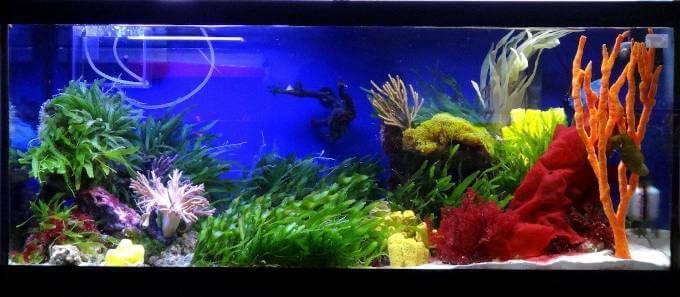
In this article
Seahorses Species
There are many different species of seahorses. Some need different care than others.
First, you should decide what species would match your criteria best.
H. Erectus, H. Reidi, and H. Kuda are the most common seahorse species for beginners. You will see these species sold by breeders and in your local fish store more often than other species.
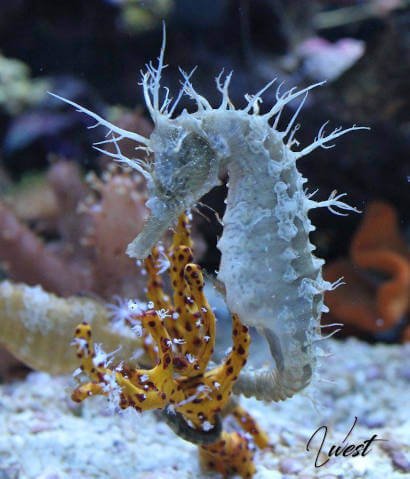
Of course there are other species sold in the aquarium trade such as potbelly’s, dwarfs, H. Barbouri, H. Comes and more. Those are usually kept by more experienced keepers.
Tank Setup
For one pair of full sized seahorses you will at least need a 30-gallon aquarium. If you’d like more than one pair, you will need to add 15 extra gallons per additional pair.

A larger volume of water gives more room for error in regards to water quality. Bad water quality and ammonia spikes can be fatal for seahorses. Ammonia burns the gills and the external plates of the seahorse. Seahorses don’t have scales, which means they are extra sensitive.
Seahorses are grazers, meaning they eat a lot throughout the day. They don’t have stomachs either, which means that food almost goes right through them. They have a very large bio-load; thus you must be on top of water changes.
A protein skimmer is a necessary component for a seahorse tank. You will need one to help maintain the large bio- load. You don’t need to have a sump to have to skimmer. There are many different HOB protein skimmers that you can use.

You’ll need optimal flow—not too much and not too little. You don’t want the seahorses to blow around the tank, but you also don’t want them to be stagnant in “dead areas.” If you are using a power head, it is extremely important that you cover them completely. The seahorses will hitch on to them if they aren’t covered, resulting in serious injury or even death. Most use a mesh covering and zip ties, some have also used a pantyhose as well.
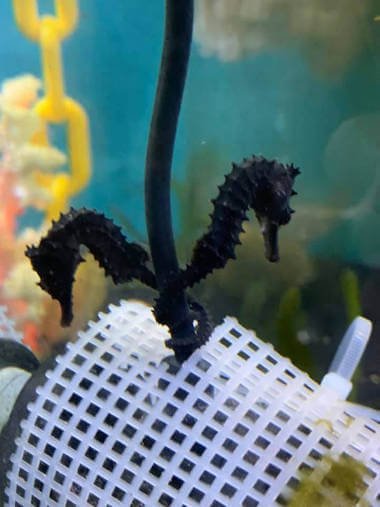
The temperature of the tank should be around 69-72 degrees Fahrenheit. The lower temperature helps prevent bacteria development. Though, different species have different needs. Be sure to do your research when you have decided on your species to find out what is best for them.
A bare bottom is also recommended, especially for first-time seahorse owners. The tank needs to be as clean as possible. Any build-up in the substrate will cause high ammonia levels, which is what you want to avoid.
Seahorses need things to hitch on to in the tank. This is very important for their overall health. There should be several different options all around the tank. It doesn’t matter if you use artificial hitches or real macro algae’s and gorgonians – it’s all a personal preference. For artificial hitches, you can use plastic chains, plastic gorgonians, and more. Make sure that what you use is plastic so it’s easy to sanitize, you should not use any type of metal or glass.
Compatible Tank Mates
There aren’t a lot of compatible tank makes for seahorses. Most fish are too aggressive and will out compete them for food. Seahorses should be kept in a species-only tank to avoid possible issues.
A clean up crew will be beneficial in your tank. Only keep snails and non-aggressive crabs that won’t bother the seahorses.
If you want to add other fish to your aquarium, gobies, pipefish and dragonet’s are a fair choice. They are pretty laid back and won’t outcompete for food sources.

Stinging coral such as anemones and torches will only harm your seahorses. If you want coral, stick with things such as zoanthids and mushrooms. Macro algae are a great choice for a seahorse tank because they also act as natural hitching posts.
Picking out a Healthy Seahorse
The key to success when keeping seahorses is the health of your seahorse to begin with. There are several things to look out for when buying a seahorse to ensure that you are not bringing home a sick fish.

There are both wild caught and captive bred seahorses sold in stores. Ideally, captive bred is what you want for various reasons. Wild caught seahorses can carry disease and parasites that infect other tank members. Wild caught seahorses usually only eat live foods. Brine shrimp, mysis shrimp, and ghost shrimp are their first choice. It can be timely and expensive sustaining a live food source of that nature.
What to look for when picking out your seahorse
- If the belly’s caved in, it is a sign of malnourishment. It is unlikely to bring a seahorse back from that point.
- Look for visible parasites such as ich, sores, torn fins, or lacerations on the tail or body.
- Rapid eye movement. The seahorse should be aware of its surroundings. Their eyes should be moving around often.
- Always ask to see the seahorse eat and make sure you know if they eat frozen food or live foods only.
- Try to avoid getting a seahorse that is in the same system with fish. If they are using the same sump, try to avoid it. It’s recommended to only buy seahorses that are in their own system. There will be less of a chance that they’re infected with parasites or disease.
Feeding Requirements
The most high maintenance part about seahorses is their feeding schedule. They need to eat a minimum of 3 times a day to stay healthy and well nourished. Ideally, they should be fed around 5 times a day. In the wild they graze all day long. It’s beneficial to have a copepod or amphipod population in the tank. They can snack on those throughout the day if they wish.
Typically, seahorses eat frozen mysis shrimp. If they eat live food, they will eat live mysis, ghost shrimp or gut loaded brine shrimp. Brine shrimp alone are not very nutritious. If you’re going to feed brine shrimp to your seahorses, you must gut load them with phytoplankton first. Gut loading ensures the seahorses are receiving nutrition. A mixed diet of frozen mysis and live feed as an occasional treat will keep your seahorses very happy.
Maintenance
To maintain water quality, remove all extra food from the tank 30 minutes after a feeding.
A siphon works well to suck out the extra debris. You can also use a net, just make sure to get out as much food as you can.
Weekly water changes are very important for keeping your seahorses happy and healthy. A 15-20% water change should be done once a week to keep levels stable and keep ammonia as low as possible.
If you have artificial hitches, disinfect those often with diluted white vinegar. This prevents bacteria build up and algae growth.
Breeding
Seahorses are not shy when it comes to breeding – especially in captivity. Owners who have a breeding pair of seahorses will expect babies to come about once a month or every other month. They also birth a rather large amount of fry at a time.
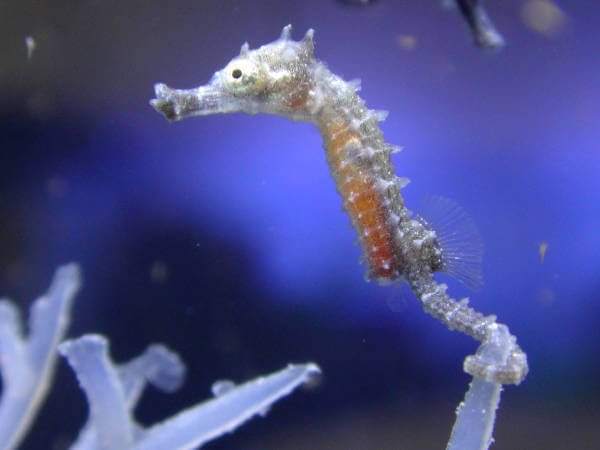
Raising fry is no easy task. If you’re not willing to put the time and money in to their care, it’s best to keep seahorses of the same sex. Some males are advertised as having a prolapsed pouch. That means he will most likely not be able to carry eggs. (yes, the male seahorse carries the eggs and gives birth.)
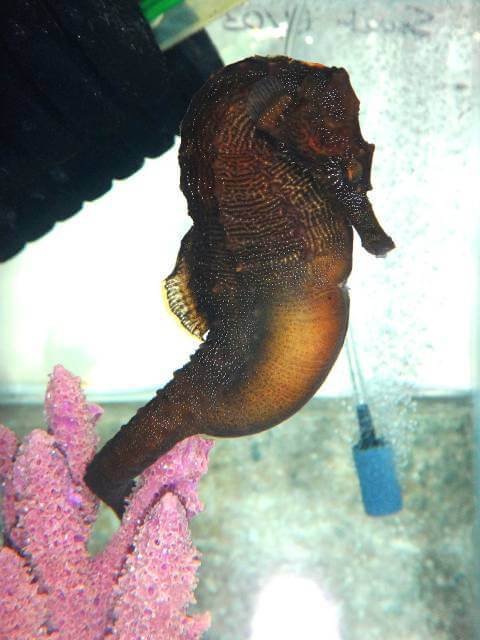
That’s not always true though. If you don’t want fry, do not take the chance with a male advertised as having a prolapsed pouch. There is no promise you won’t wake up to a batch of fry in your tank one morning.
Medication
Seahorses are easily susceptible to bacterial infections and parasites. Males can suffer from pouch emphysema, which means they can get air bubbles stuck in their pouch. Thus causing buoyancy issues.
If you’re able, keep these medical supplies on hand to be able to treat a sick or injured seahorse right away.
What you should have on hand
- For bacterial infections- Triple Sulfa, Furan 2, Kanamycin
- Antiparasitic- Formalin 37% (Used for external parasites and parasites in gills and oral cavities)
- Topical Antiseptic- Neosporin. Betadine, Allicin, Biobandage, etc. (Used on wounds and open sores)
- 18 ga IV Catheter without needle, or bobby pin (Pouch evacuation)
Those are the basic medical supplies and medications to keep on hand for your seahorse. Do not medicate the display tank.
Fish Keeping 101: Always have an extra 10-gallon aquarium and air pump. That way you can easily set up a hospital tank with fresh saltwater for treatment.
Closing Thoughts
Keeping seahorses is such a rewarding, delightful, and amazing experience. Their big personalities shine through so bright. It’s guaranteed to make you smile every day. They are a huge commitment, though – so don’t take caring for them lightly. If not cared for properly, you will have more bad days than good days with these little guys. If cared for properly, you’re in for a great adventure with some unique creatures. One of the best parts is when they start to recognize you and come out to see you.
Of course there will always be more to learn, but hopefully this information has been helpful for you. Be diligent, do your research, and learn from your mistakes.